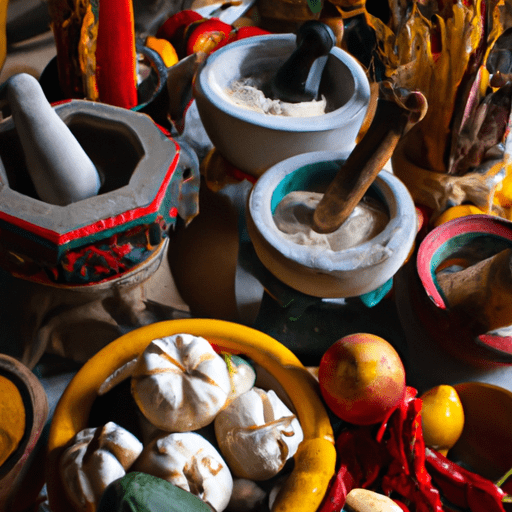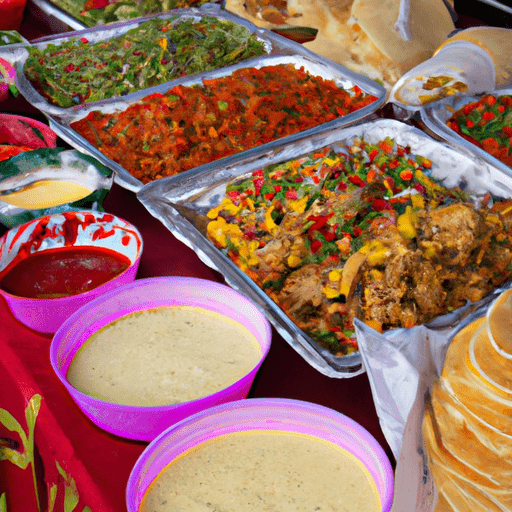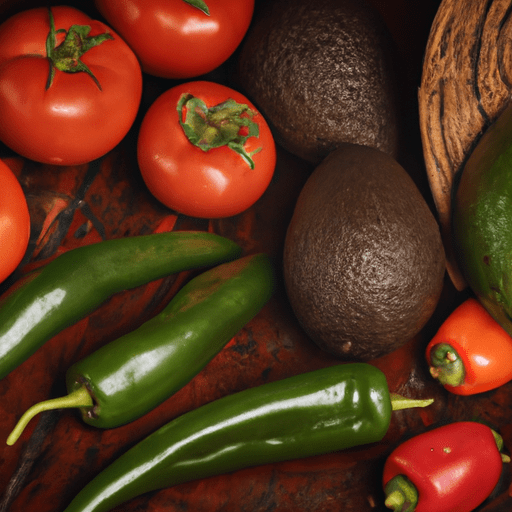Introduction
Craving a culinary adventure that will tantalize your taste buds? Look no further than Mexican restaurants! With their vibrant flavors and diverse menu options, these eateries offer an authentic experience that showcases the rich culture and heritage of Mexico. From mouthwatering street food to exquisite fine dining, Mexican restaurants cater to all palates and preferences.
The popularity of Mexican cuisine has skyrocketed worldwide, with communities embracing its bold spices and unique ingredients. Whether you’re in search of a quick takeout option or a sit-down meal at a local hotspot, Mexican restaurants have got you covered. Their online ordering services make it convenient to satisfy your cravings from the comfort of your own home.

The History and Diversity of Mexican Cuisine
Mexican cuisine is a culinary tradition with a rich history that spans thousands of years. Influenced by indigenous cultures and Spanish colonization, it has evolved into a diverse and flavorful cuisine that is loved worldwide. Let’s delve into the fascinating history and vibrant diversity of Mexican cuisine.
Long-standing Culinary Traditions
Mexican cuisine can trace its roots back to ancient civilizations such as the Aztecs, Maya, and Olmecs. These indigenous cultures cultivated crops like corn, beans, chili peppers, tomatoes, and various herbs and spices. These ingredients formed the foundation of their diet and continue to be staples in Mexican cooking today.
The arrival of Spanish conquistadors in the 16th century brought about significant changes to Mexican cuisine. European ingredients like wheat, rice, pork, beef, cheese, and dairy products were introduced to Mexico. The fusion of these new ingredients with indigenous ones gave rise to unique flavor profiles that are characteristic of Mexican dishes.

Regional Diversity in Flavors
One remarkable aspect of Mexican cuisine is its regional diversity. Each region within Mexico has its own distinct culinary traditions and specialties. From the coastal regions to the highlands and deserts, every area boasts a unique array of flavors and ingredients.
In Northern Mexico, for example, you’ll find dishes heavily influenced by cowboy culture with an emphasis on grilled meats like carne asada (grilled steak) or cabrito (roast goat). In contrast, Southern Mexico showcases flavors influenced by Mayan traditions with dishes like cochinita pibil (slow-roasted pork) or tamales wrapped in banana leaves.
Central Mexico is home to some iconic dishes such as mole poblano (a complex sauce made from chili peppers and chocolate), chiles en nogada (stuffed poblano peppers topped with walnut sauce), and pozole (a hearty soup made with hominy corn).
A Melting Pot of Flavors
The diversity in Mexican cuisine can also be attributed to the fusion of various culinary influences. Indigenous ingredients and cooking techniques merged with Spanish, African, Caribbean, and even Middle Eastern flavors over time.
For instance, Mexican street food showcases the influence of both indigenous and European cultures. Tacos al pastor, a popular street food dish, is believed to have been inspired by shawarma brought by Lebanese immigrants. It features marinated pork cooked on a vertical spit and served with pineapple, onions, cilantro, and salsa.
The coastal regions of Mexico have incorporated seafood into their culinary repertoire due to their proximity to the ocean. Ceviche, a dish made from raw fish or shrimp marinated in lime juice with onions, tomatoes, and chili peppers, is a refreshing example of this coastal influence.
Modern-Day Mexican Cuisine
The fusion of indigenous ingredients with European cooking techniques has shaped modern-day Mexican cuisine into a vibrant tapestry of flavors. Chefs across Mexico continue to innovate while staying true to traditional recipes and local ingredients.
Mexican restaurants around the world strive to capture the essence of this diverse cuisine. They offer an array of dishes ranging from classics like tacos and enchiladas to contemporary interpretations that showcase creativity and unique flavor combinations.
Mexican cuisine’s popularity has soared globally due to its bold flavors, fresh ingredients, and versatility. Whether you’re savoring a plate of sizzling fajitas or indulging in creamy guacamole with crispy tortilla chips, each bite transports you on a flavorful journey through Mexico’s rich culinary heritage.
Exploring Traditional Mexican Dishes and Flavors

Traditional Mexican cuisine is a vibrant and diverse culinary experience that tantalizes the taste buds with its bold flavors and rich cultural heritage. From tacos to tamales, mole sauce to chiles rellenos, there are countless traditional dishes to discover and savor. Let’s delve into the world of Mexican flavors and explore some of the mouthwatering delicacies this country has to offer.
Traditional Mexican Dishes
There is an abundance of options that will leave you craving for more. Here are some iconic favorites:
Tacos: These delicious handheld treats consist of soft or crispy tortillas filled with various ingredients such as grilled meats (like carne asada or al pastor), seafood, vegetables, and flavorful salsas.
- Enchiladas: Rolled tortillas stuffed with fillings like shredded chicken or cheese, then smothered in chili sauce before being baked or fried to perfection.
- Tamales: A labor-intensive dish made from masa dough filled with savory or sweet fillings like meat, cheese, fruits, or chocolate. They are wrapped in corn husks and steamed until tender.
- Mole Sauce: This complex sauce combines multiple ingredients like chili peppers, chocolate, nuts, spices, and even fruits to create a rich and velvety concoction that pairs beautifully with chicken or pork.
- Chiles Rellenos: Large poblano peppers stuffed with cheese or meat filling, dipped in egg batter, deep-fried until golden brown, and served with tomato-based sauces.
- Pozole: A hearty soup made from hominy (dried corn kernels treated with an alkali solution) simmered with meat (usually pork), seasoned with herbs and spices for a comforting meal.
Bold and Complex Flavors

The flavors found in traditional Mexican cuisine are nothing short of extraordinary. The combination of ingredients and spices creates a symphony of tastes that excite the palate. Here are some key elements:
- Spicy Chili Peppers: From mild to fiery, chili peppers like jalapeños, serranos, poblanos, and habaneros add heat and depth to dishes.
- Tangy Citrus Fruits: Lime and lemon juice are commonly used to provide a refreshing tanginess that balances out the spiciness in many Mexican dishes.
- Aromatic Herbs and Spices: Cilantro, cumin, oregano, and cinnamon are just a few examples of the herbs and spices that lend their distinctive flavors to Mexican cuisine.
- Corn: Corn is a staple ingredient in Mexican cooking and is used in various forms such as tortillas, tamales, or pozole. It adds a subtly sweet flavor and unique texture to dishes.
- Rich Cheeses: Mexican cheeses like queso fresco, queso blanco, or Oaxaca cheese bring creamy goodness to many traditional recipes.
Sweet Endings
No meal is complete without indulging in some delectable desserts from Mexico. Traditional Mexican sweets offer a delightful conclusion to any culinary adventure. Here are two popular options:
- Flan: This creamy caramel custard dessert is made with eggs, milk or condensed milk, sugar, vanilla extract, and topped with a luscious caramel sauce.
- Tres Leches Cake: A moist sponge cake soaked in three types of milk (evaporated milk, condensed milk, and heavy cream), resulting in a decadent treat that melts in your mouth.
Key Ingredients in Authentic Mexican Cuisine
In the vibrant world of Mexican cuisine, there are key ingredients that bring life and flavor to traditional dishes. Let’s explore some of these essential elements that make Mexican food so deliciously unique.
Corn (Maize)
Corn, or “maize” as it is known in Mexico, holds a special place in the heart of Mexican cuisine. It is a staple ingredient used in various forms, such as tortillas, tamales, and pozole. The versatility of corn allows it to be transformed into different textures and flavors, adding depth to many traditional dishes.
Beans (Frijoles)
Beans are another crucial component of authentic Mexican cooking. Frijoles, whether black beans or pinto beans, provide a rich source of protein and fiber. They are often cooked with aromatic spices and herbs to create flavorful side dishes or fillings for tacos and burritos.
Avocados (Aguacate)
No discussion about Mexican cuisine would be complete without mentioning avocados. These creamy green fruits add a luscious texture to dishes like guacamole and salsa verde. The buttery flavor of avocados pairs perfectly with other ingredients to create a harmonious taste experience.
Tomatoes (Jitomate)
Tomatoes play a fundamental role in Mexican cuisine by providing acidity and sweetness to various dishes. Whether they are used fresh in salsas or cooked down into rich sauces like mole, tomatoes add vibrant color and robust flavor profiles.
Cilantro (Coriander)
Cilantro is an herb widely used in Mexican cooking for its distinct aroma and refreshing taste. Its bright leaves bring freshness to salsas, soups, and marinades. While some people may find cilantro polarizing due to its unique flavor profile, it remains an integral part of authentic Mexican recipes.
Lime (Limón)
Lime juice adds a tangy and zesty element to many Mexican dishes. It is commonly squeezed over tacos, grilled meats, or even used in refreshing beverages like margaritas. The acidity of lime balances the richness of other ingredients and enhances the overall flavor profile.
Onions (Cebolla) and Garlic (Ajo)
Onions and garlic form the aromatic base of countless Mexican recipes. They are sautéed together to create a flavorful foundation for stews, sauces, and salsas. The combination of these two ingredients adds depth and complexity to traditional Mexican dishes.
Chili Peppers
Chili peppers are an essential ingredient in Mexican cuisine, providing both heat and flavor. From mild jalapeños to fiery habaneros, chili peppers come in various shapes and sizes, each with its unique taste profile. Whether they are used fresh or dried, chili peppers add a spicy kick to salsas, marinades, and meat fillings.
Epazote
Epazote is an herb that may not be as well-known outside of Mexico but plays a significant role in traditional Mexican cooking. Its distinct aroma has been described as earthy with hints of citrus and mint. Epazote is often used in bean dishes like refried beans or black bean soup to enhance their flavors.
Pork
Pork is widely utilized in Mexican cuisine due to its versatility and ability to absorb flavors. It is commonly used in dishes such as carnitas (slow-cooked pork) or chorizo (spicy sausage). The richness of pork adds depth to various stews, tacos, and tamales.
Popular Mexican Appetizers and Salsas
In Mexican cuisine, appetizers play a crucial role in setting the stage for a delicious meal. Let’s take a closer look at some popular Mexican appetizers and salsas that are sure to tantalize your taste buds.
Guacamole: A Beloved Mexican Appetizer
One cannot talk about Mexican appetizers without mentioning the beloved guacamole. Made with mashed avocados, onions, tomatoes, lime juice, and cilantro, guacamole is a true crowd-pleaser. The creamy texture of avocados combined with the tanginess of lime juice creates a perfect balance of flavors. Whether you’re enjoying it with tortilla chips or using it as a topping for tacos or burritos, guacamole adds a refreshing and satisfying element to any dish.
Salsas: An Integral Part of Mexican Cuisine
Salsas are an integral part of Mexican cuisine, adding vibrant flavors and heat to various dishes. From mild to fiery hot, there is a salsa for every palate. These versatile condiments are made with different chili peppers like jalapenos, serranos, or habaneros, along with other ingredients such as tomatoes, onions, garlic, cilantro, and lime juice. Each region in Mexico has its unique salsa recipes that reflect their local flavors.
Some popular types of salsas include:
- Pico de Gallo: This fresh salsa combines diced tomatoes, onions, jalapenos (or other chili peppers), cilantro, lime juice, and salt. It adds a burst of freshness to any dish.
- Salsa Verde: Made with tomatillos (green tomatoes), jalapenos or serrano peppers, onions, garlic, cilantro, and lime juice; this green salsa offers a tangy and slightly spicy flavor profile.
- Salsa Roja: Also known as red salsa or cooked salsa, it is made with tomatoes, onions, garlic, chili peppers, and various spices. It has a rich and smoky flavor that pairs well with grilled meats or tacos.
Queso Fundido: A Cheesy Delight
If you’re a cheese lover, then queso fundido is a must-try Mexican appetizer. This melted cheese dip is typically made with melted Oaxaca or Monterey Jack cheese combined with sautéed onions, bell peppers, and sometimes chorizo for an extra kick of flavor. The gooey and indulgent queso fundido is best enjoyed when served hot with tortilla chips or warm tortillas. It’s the perfect comfort food to share with friends or family.
Ceviche: A Refreshing Seafood Delight
For seafood enthusiasts, ceviche is a refreshing and flavorful appetizer that originates from coastal regions in Mexico. Ceviche typically consists of marinated raw fish or seafood such as shrimp or scallops in citrus juices like lime or lemon. As the fish marinates in the acidic juices, it “cooks” and becomes tender while retaining its fresh flavors. The ceviche is often mixed with diced tomatoes, onions, cilantro, and sometimes avocado for added creaminess. It’s a light yet satisfying dish that makes for a perfect starter on a warm summer day.
Regional Variations in Mexican Cuisine
There’s so much more than just tacos and guacamole. Each region in Mexico has its own unique culinary traditions and flavors that reflect the local communities and cultural influences. Let’s explore some of the regional variations in Mexican cuisine.
Northern Mexico: Grilled Meats Galore
In Northern Mexico, you’ll find a strong influence from cowboy culture and ranching traditions. This region is known for its mouthwatering grilled meats, such as carne asada (grilled beef) and cabrito (roast goat). The meat is often marinated with flavorful spices before being cooked over an open flame or on a grill. These dishes are typically served with warm tortillas, salsa, and fresh toppings like guacamole and pico de gallo.
Yucatan Peninsula: Mayan Delights
The Yucatan Peninsula region showcases a fusion of Mayan flavors with Spanish influences. One popular dish is cochinita pibil, which features slow-roasted pork marinated in citrus juices and achiote paste. The result is tender, flavorful meat that melts in your mouth. Another specialty is papadzules, rolled tortillas filled with hard-boiled eggs and topped with pumpkin seed sauce. These unique dishes offer a glimpse into the ancient Mayan culinary heritage.
Oaxaca: Mole Magic
Oaxaca, located in southern Mexico, is renowned for its rich moles (sauces) that come in various colors and flavors. Mole negro is one of the most famous varieties—a complex blend of chilies, chocolate, spices, nuts, and seeds that creates a velvety sauce perfect for smothering chicken or enchiladas. Another Oaxacan delight is tlayudas—large crispy tortillas topped with refried beans, meat (such as tasajo or chorizo), cheese, and fresh vegetables. These regional specialties showcase the depth and complexity of Oaxacan cuisine.
Veracruz: Coastal Culinary Treasures
Veracruz, a coastal state in eastern Mexico, offers a vibrant seafood-centric cuisine influenced by its proximity to the Gulf of Mexico. One must-try dish is huachinango a la veracruzana, which features red snapper cooked in a zesty tomato sauce with olives, capers, and aromatic herbs. The combination of fresh fish and bold flavors creates a truly memorable dining experience. Veracruz is also known for its tasty ceviche—a refreshing dish made with marinated raw fish or shrimp mixed with citrus juices, onions, cilantro, and other seasonings.
Vegetarian and Vegan Options in Mexican Restaurants
Mexican cuisine is known for its bold flavors, vibrant colors, and hearty dishes. While many traditional Mexican dishes feature meat as a main ingredient, there are plenty of delicious options available for vegetarians and vegans. By making simple substitutions or modifications, you can enjoy the rich flavors of Mexican cuisine while adhering to your dietary preferences.
Vegetarian Options: Chiles Rellenos and More
One of the most popular vegetarian options in Mexican restaurants is chiles rellenos. These are typically made by stuffing poblano peppers with cheese or vegetable fillings such as corn, mushrooms, or zucchini. The stuffed peppers are then battered and fried until golden brown. Chiles rellenos offer a satisfying combination of flavors and textures that are sure to please any vegetarian palate.
In addition to chiles rellenos, there are several other vegetarian dishes commonly found in Mexican restaurants. Here are a few examples:
- Vegetable Tacos: Tacos filled with grilled vegetables like bell peppers, onions, and zucchini make for a tasty and filling meal.
- Enchiladas Verdes: These enchiladas are filled with cheese and topped with a tangy green salsa made from tomatillos. They can be served with rice and beans for a complete vegetarian meal.
- Quesadillas: Quesadillas filled with cheese, sautéed vegetables, or even mashed black beans offer a quick and easy option for vegetarians.
Mexican cuisine also incorporates an abundance of fresh ingredients like avocados, tomatoes, cilantro, and lime juice. These elements add brightness and flavor to vegetarian dishes while keeping them light yet satisfying.
Vegan Options: Plant-Based Delights
For those following a vegan diet who avoid all animal products including dairy and eggs, Mexican restaurants often have several plant-based options available. Here are some vegan-friendly dishes to look out for:
- Vegan Tacos: Instead of meat or cheese, these tacos are filled with grilled vegetables, seasoned tofu, or even plant-based proteins like seitan or tempeh.
- Sopes: Sopes are small corn masa cakes topped with a variety of ingredients. Vegan sopes can be filled with beans, guacamole, salsa, and other vegan-friendly toppings.
- Arroz con Frijoles: This classic Mexican dish consists of rice cooked with beans and spices. It is often served as a side dish but can also be enjoyed as a main course by vegans.
Mexican cuisine embraces the use of spices and herbs to create bold flavors. Even without animal products, vegan dishes in Mexican restaurants can be incredibly flavorful and satisfying.
Rice-Based Dishes: A Vegan-Friendly Option
Another vegan-friendly option commonly found in Mexican restaurants is rice-based dishes. Arroz con frijoles (rice with beans) is a staple that can be enjoyed as a side dish or even as a main course for vegans. The combination of fluffy rice and savory beans provides a good source of protein and fiber.
In addition to arroz con frijoles, there are other rice-based options that can be made vegan by omitting any animal ingredients such as chicken broth or lard. These may include dishes like Spanish rice (also known as Mexican rice) or cilantro lime rice.
Enhancing Your Dining Experience: Pairing Mexican Food and Beverages
From tequila to Mexican beers and traditional beverages, there’s a wide range of options to complement the flavors of your favorite dishes.
Tequila: The Iconic Spirit of Mexico
Tequila is the quintessential Mexican spirit that pairs exceptionally well with various Mexican dishes. Whether you’re enjoying tacos, guacamole, or ceviche, a shot of tequila can enhance the flavors and add an extra kick to your meal. Its distinct agave flavor profile beautifully complements the spices and seasonings commonly found in Mexican cuisine.
There are different types to choose from. Blanco (silver) tequila is unaged and has a crisp, pure taste. Reposado (rested) tequila is aged for a short period in oak barrels, giving it a smoother character with subtle notes of vanilla and caramel. Añejo (aged) tequila undergoes longer aging in oak barrels, resulting in a rich and complex flavor profile.
Mexican Beers: A Refreshing Accompaniment
Mexican beers have gained worldwide popularity for their refreshing qualities that perfectly complement spicy Mexican dishes. Brands like Corona, Dos Equis, or Modelo are often served with lime wedges, which add a zesty twist to the drinking experience.
These light-bodied beers provide a crisp and clean palate cleanser while balancing out the heat from spicy salsas or enchiladas. The effervescence of carbonation helps refresh your taste buds between bites, making each sip as enjoyable as the last.
Traditional Mexican Beverages: A Taste of Authenticity
If you’re looking for non-alcoholic options or simply want to explore traditional Mexican beverages, there are two popular choices worth trying—horchata and agua fresca.
Horchata is a rice-based drink infused with cinnamon and sweetened with sugar. Creamy, slightly nutty, and delicately spiced, it offers a refreshing respite from the bold flavors of Mexican cuisine. The combination of rice and cinnamon creates a unique flavor profile that pairs harmoniously with dishes like mole or tamales.
Agua fresca, on the other hand, refers to fruit-infused water that comes in various flavors such as hibiscus (jamaica), melon (cantaloupe), or cucumber-lime. These vibrant and naturally sweet beverages provide a light and thirst-quenching option to accompany your meal. Agua frescas are particularly popular during hot summer months when their cooling properties offer relief from the sweltering heat.
Margaritas: A Classic Mexican Cocktail
No discussion about pairing Mexican food and beverages would be complete without mentioning margaritas. This classic cocktail is made with tequila, lime juice, and orange liqueur (typically triple sec or Cointreau). It’s often served on the rocks or blended with ice for a frosty treat.
Margaritas are renowned for their tangy yet refreshing taste that perfectly complements the bold flavors of Mexican cuisine. The citrusy notes of lime combined with the smoothness of tequila create a delightful harmony on your palate. Whether you prefer it traditional, flavored (like strawberry or mango), or even frozen, margaritas are an excellent choice for enhancing your dining experience at a Mexican restaurant.
Conclusion: Celebrating the Richness of Mexican Cuisine
From its rich history and diverse regional variations to the tantalizing array of traditional dishes and flavors, you now have a deeper appreciation for this culinary gem. But our exploration doesn’t end here – it’s time to put your newfound knowledge into action!
Now that you’re armed with insights into key ingredients, popular appetizers, regional variations, vegetarian options, and beverage pairings, it’s time to satisfy your cravings at an authentic Mexican restaurant near you. Immerse yourself in the lively atmosphere as you savor every bite of delicious tacos, enchiladas, or tamales. Indulge in zesty salsas and explore the bold flavors that make Mexican cuisine so unique.
FAQs
Can I find vegetarian options at a Mexican restaurant?
Absolutely! Many Mexican restaurants offer a variety of vegetarian options. From veggie-packed tacos and burritos to flavorful salads and grilled vegetable fajitas, there are plenty of choices to satisfy your cravings.
Are there gluten-free options available in Mexican cuisine?
Yes! Authentic Mexican cuisine often includes naturally gluten-free ingredients like corn tortillas instead of flour tortillas. However, always inform your server about any dietary restrictions or allergies so they can guide you towards suitable menu items.
What is the difference between Tex-Mex and authentic Mexican cuisine?
Tex-Mex refers to a fusion of American and Mexican cuisines that developed along the Texas-Mexico border. It often includes dishes like nachos, chili con carne, and crispy tacos. Authentic Mexican cuisine focuses more on traditional dishes and flavors specific to different regions of Mexico.
Can I enjoy Mexican cuisine if I don’t like spicy food?
Absolutely! While Mexican cuisine is known for its bold flavors and occasional spiciness, not all dishes are fiery hot. Many restaurants offer milder options or can adjust the spice level according to your preference.
Are there dessert options in Mexican cuisine?
Yes, indeed! Mexican desserts are a delightful way to end your meal. From the creamy richness of flan and tres leches cake to the warm sweetness of churros with chocolate dipping sauce, you’ll find a range of delectable treats to satisfy your sweet tooth.
Frequently Linked Pages
1. mexican restaurant near .me – Mexican Restaurants Near .Me – Uncover the Best Authentic Spots!
2. mexican restaurant near me – Mexican Restaurant Near Me – Authentic Flavors Await!
3. mexican restaurants near me – Mexican Restaurants Near Me: Discover Authentic Flavors Right Around the Corner
4. mexican restaurant near to me – Mexican Restaurant Near To Me: Discovering Local Flavors and Culinary Delights








